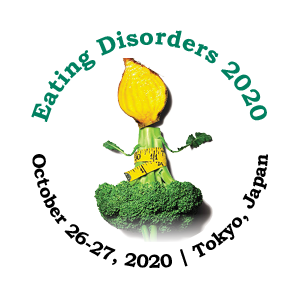About Conference
Conference Series llc LTD welcomes you to World congress on Nutrition & Eating Disorders, going to be held in October 26-27, 2020. at Tokyo, Japan. We invite you to join us at, Eating Disorder 2020 where you will be sure to have knowledge with scholars from around the world for a good health. World-renowned speakers, the most recent methods, progresses, and the newest updates in Eating Disorders, Obesity and Nutrition conferences are hallmarks of this conference.
Increase in the health problems, modern lifestyle are the major concerns for health issues related to eating disorders. Annual congress on Eating Disorders, Obesity and Nutrition is a global forum to propound and learn about the concatenated nature of eating, nutrition and obesity. Eating disorder 2020 is being hosted to emphasize on the anticipation for enhanced and secure life. Eating disorder leads to Anorexia Nervosa, Bulimia Nervosa, and Binge Eating Disorder, obesity related issues, nutritional deficiencies. This conference concentrates on mitigating the problems related to highlighting on the preventive measures and the recent advancements that meet fitness.
We are sure that the World Congress on Nutrition & Eating disorder 2020 , will be a unique opportunity for high quality scientific program with session lectures, symposia, workshops, poster presentations and different programs for participants from throughout the world.
Conference Series llc LTD organizes 1000+ Global events every year across USA, Europe, & Asia-pacific regions with support from more than 1000 more scientific societies and publishes 700+ Open access journals which contains over 50000 eminent personalities, reputed scientists as editorial board members and reviewers
WHY TO ATTEND
Congress on Eating Disorder 2020 gives an opportunity to meet with industry professionals and similarly individuals. Gatherings unite individuals from all unique land territories who share a typical teach or field. Meetings give you the chance to converse with these individuals one-on-one about what they are really going after, and they may even give you counsel without anyone else work. At these Eating Disorder 2020 Meetings, you have the chance to get input on your work from individuals who have never observed it and may give new knowledge. Quickly it is a put resource into yourself, your profession and your organization.
WHO TO ATTEND
Target audience are Dieticians, Fitness Authorities, Healthcare Providers, including Obstetrics, Endocrinologists, Dieticians, Paediatrics, Ophthalmologists, Pharmacists, Nutritionists, Industry Professionals, Weight loss Specialists.
WHY TOKYO
Anorexia is more common in Japan specifically, as opposed to other countries.The prevalence rate of eating disorders is difficult to assess because in both anorexic and bulimic cases, the percentage of people that actually visit doctors is very low. Also, the prevalence rate depends on whether to include the increasing grey zone of people with lighter symptoms. If we only include patients that meet all the diagnostic criteria, the prevalence rate of anorexia nervosa in young females in Japan is considered to be slightly less than 1%, and 2% for bulimia nervosa, as in other developed countries. Currently, the average number of new onset anorexic sufferers in developed countries is five to seven in every 100,000, and it is evaluated to be the same for Japan. It might seem like a small number, but this means Tokyo alone has 600 to 800 new anorexic patients every year. And this does not count potentially anorexic people who do not see doctors.”
Regardless of the statistics, one of the biggest problems is lack of support. According to Nishizono-Maher, most developed countries have dedicated treatment facilities for eating disorders, yet there are none in Japan, aside from a few independent support groups such as TELL and community forums. In 2014, a division was established in the National Institute of Mental Health (NCNP) called the Center for Eating Disorder Research and Information (CEDRI), which allowed some studies and educational activities to be carried out. Under this center, several prefectures are working toward creating treatment and support programs. Unfortunately, there is yet to be a medical facility specializing in eating disorder treatment founded in Tokyo.
Sessions and Tracks
1. Eating Disorder
An eating disorder is a condition in which a person takes excessive food intake which affects a person's physical or mental health. It occurs in both men and women, young and old, rich and poor, and from all cultural backgrounds. The most common eating disorders include Anorexia Nervosa, Bulimia Nervosa, and Binge Eating Disorder. It can develop during in any stage in life but appears in teens and young adulthood. According to the survey conducted by the National Eating Disorder Association around the word 70 million people are prone to eating disorders. Since 1990's dietary problems have been progressively regular in Singapore.
-
Anorexia Nervosa
-
Adolescent eating and weight loss behaviour
-
Bulimia Nervosa
-
Abnormal and maladaptive eating
-
Binge Eating Disorder
-
Food Addiction
2. Eating Disorders Symptoms & Behaviours
Eating disorders symptoms and behaviours are complex. Many are caused by malnutrition. Some physical symptoms of eating disorders are weakness, feeling cold, reduced beard growth in men, Sleep problems, Dental problems, Muscle weakness Other possible manifestations are dry lips, burning feeling on tongue, parotid gland swelling. Though often associated with obesity it can occur in normal weight individuals also.
-
Amenorrhea
-
Reduction in walking erections
-
Ritualistic Food behaviours
-
Low body Weight
-
Cognitive disorientation
3. Biology & Pharmacology of Eating Disorder
Scientists are still researching possible biochemical or biological causes of eating disorders. In some individuals with eating disorders, certain chemicals in the brain that control hunger, appetite, and digestion have been found to be unbalanced. The exact meaning and implications of these imbalances remain under investigation. Eating disorders often run in families. Current research indicates that there are significant genetic contributions to eating disorders.
-
Antidepressants
-
BDNF - brain-derived neurotropic factor Cortisol
-
Genetic predisposition
-
Over-the Counter Drugs (OTC)
-
Selective Serotonin Reuptake Inhibitor (SSRI)
4. Nutrition Therapy In Eating Disorder
Medical Nutrition Therapy (MNT) is a holistic and therapeutic method for treating medical conditions and correlating symptoms. Medical Nutrition Therapy is established on the idea that several medical conditions progress or are made worse by an inadequate diet or insufficient nutrient intake. The components of MNT include; Intake assessment, Dietary modification, Patient education, Aftercare. Therapy also includes creating goals for the patient’s treatment and developing a focused nutrition prescription that entails patient education along with self-management training. Initial nutrition therapy assessment sessions may occur over a period of 60-75 minutes. Medical Nutrition Therapy for several diseases and conditions with the intent of improving overall health and quality of life. The goal of MNT in the eating disorder treatment is to stabilize complicated medical conditions, normalize food intake, establish healthier and normal eating behaviours, and promote the founding for an improved relationship with food.
-
Chronic/Severe dieting
-
Eliminating specific food items
-
Intake assessment
-
Dietary modification
-
Hunger and Fullness
-
Healthy exercise
-
Nutritional supplement assessment
5. Current Treatment and Approaches
Treatment for an eating disorder can rely upon the specifics of the disorder and can be tailored to every individual. Generally, the goals of eating disorder treatment are to restore the person to a healthy weight, treat any psychological issues associated with or coexisting with the disorder, and reduce in behaviour or thoughts that contribute to the disorder. Alternative therapies may be helpful for a few individuals as an adjunct to psychological, nutritional and medical treatments. For example meditation will facilitate the reducing levels of anxiety or massage will facilitate to reconnect with our bodies. Every approach is totally different, but different therapies are typically involved with treating the person as a whole, as well as their mental and physical health.
-
Dialectical Behaviour Therapy
-
Medical Nutrition Therapy
-
Equine Therapy
-
Acceptance and Commitment Therapy
-
Art Therapy
-
Dance Movement Therapy
-
Exposure and Response Prevention Therapy
6. Complications of Eating Disorders
Eating disorders cause a wide variety of complications, some of them life-threatening. The more severe or long lasting the eating disorder, the more likely you are to experience serious complications. Some of the underlying issues that are associated with an eating disorder include low self-esteem, depression, feelings of loss of control, feelings of worthless, identity concerns, family communication problems and an inability to cope with emotions. Patient suffering from anorexia nervosa will have a number of potential complications which include minor side effects such as fatigue or lack of energy as well as major on-going health problems or even death. Whereas patient suffering from Bulimia nervosa often feel trapped in this cycle of deregulated eating, and there is a risk for major medical consequences associated with bulimic behaviours.
-
Reduce bone density
-
Constantly feeling cold
-
Muscle weakness
7. Obesity
Obesity is a medical condition where the excess body fat accumulates in the body to an extent that it has a negative effect on health. It is defined by using body mass index (BMI) and is evaluated in terms of fat distribution and total cardiovascular risk factors. IF a person’s body weight is more than 20% is consider as obese .Prevention of Obesity can be done by changes in diet, exercising and other medical treatments. Obesity is most commonly caused by a combination of excessive intake, lack of physical activity, and genetic susceptibility. A person is more likely to develop obesity if one or both parents are obese. Obesity can be prevented by changes in diet, exercising and other medical treatments.
-
Types of Obesity
-
Epidemiology of Obesity
-
Global Issues
8. Genetics of Obesity
In 2001, six genes were connected to monogenic human weight and no normal variations were connected with polygenic weight. However genes do not always predict future health but genes and behaviour may both be needed for a person to be overweight. The % of obesity which can be attributed to genetics varies widely depending on the population.Genes can cause obesity disorders as Bardet-Biedl syndrome and Prader- willi syndrome. In some cases multiple genes may increase one’s susceptibility for obesity and require outside factors; such as abundant food supply or little physical activity. We propose an ignore of significant lessons gained from 15 years of research in the field of the hereditary qualities and weight.
-
Biological pathways
-
Genetic continuums
-
Cellular, Molecular and Genetic bases of Obesity
-
Hereditary Factors
9. Obesity & Weight Management
Obesity Management includes lifestyle changes, medications, or surgery and the main treatment for obesity consists of dieting and physical exercise. Knowing what your body desires is very important to weight management and may control overconsumption and under consumption of food. Weight management doesn't include fad diets that promote fast, temporary weight loss. It focuses on the long-term results that are achieved through slow weight loss, followed by retention of an ideal weight for age, sex and height. . Diet programs may produce weight loss over the short term period, but maintaining this weight loss is frequently difficult and often requires making exercise and a lower calorie diet a permanent part of an individual's lifestyle.
-
Hypertension
-
Abnormal obesity
-
Dietary Supplements
-
Metabolic Outcomes
-
Pharmacologic Therapy
-
Herbal Weight loss Medication
10. New Directions in Obesity Treatment
The incidence of weight problems in the Western international has expanded dramatically at some stage in the current a long time. Treatment of obesity begins with complete way of life management (i.e., weight loss plan, bodily pastime, behaviour amendment). Scientific evidence suggests that multidisciplinary applications reliably produce and preserve modest weight reduction between 5% and 10% for the long-time period. As with all continual clinical conditions, powerful control of weight problems ought to be based on a partnership among a fairly influenced patient and a devoted group of health experts.
-
Clinical management
-
Endocrine Surgery
-
Islet cell transplantation
-
Clinical management
-
Advanced Inch Loss therapy
11. Complications with Obesity
The major diseases associated with obesity are hypertension, atherosclerosis, and diabetes, as well as certain types of cancer. Less well-known complications include hepatic steatosis, gallbladder disease, pulmonary function impairment, endocrine abnormalities, obstetric complications, trauma to the weight-bearing joints, gout, cutaneous disease, proteinuria, increased haemoglobin concentration, and possibly immunologic impairment. A U- or J-shaped curve illustrates the relation between body mass index and the degree of these various complications. This relationship can be used to provide guidelines for assessing treatment of obesity.
-
Coronary heart disease
-
Type 2 diabetes
-
Stroke
-
Gallstones
-
Osteoarthritis
12. Obesity and Oncology
The link between obesity and risk for several kinds of cancer is currently well established by over a decade of scientific research. Overweight or obesity is liable for nearly twenty fifth of the relative contribution to cancer incidence that ranks second solely to tobacco use. Obesity is strongly tied to several of the most common types of cancers, are post-menopausal carcinoma, colorectal cancer and cancers of the endometrium, kidney, thyroid and bladder. However, evidence is less convincing and somewhat controversial for prostate cancer, lung cancer and pre-menopausal breast cancer; several studies report an inverse relationship between obesity and these particular cancers.
-
Obesity and breast cancer
-
Obesity and thyroid cancer
-
Obesity and Colorectal cancer
13. Current Research on Obesity
During the previous 20 years, obesity among grown-ups has risen altogether in the United States. The most recent information from the National Center for Health Statistics demonstrates that 33% of U.S. grown-ups 20 years old and more established—more than 100 million individuals—are stout. This expansion is not restricted to grown-ups, but rather has likewise influenced youngsters. Among youth, 18 percent of kids matured 6-11 years and 21 percent of youngsters matured 12–19 years are viewed as obese. These rates of obese have significant ramifications for Americans' wellbeing. Albeit one of the national well-being goals for the year 2020 is to diminish the commonness of stoutness among grown-ups by 10 percent, current information shows that the circumstance is not progressing. Hopkins GIM employees are examining overweight the full scope of its characteristic history and difficulties, and in addition attempting to battle the plague by exploring different techniques and intervention
-
Diabetes and its complications
-
Probiotics for human health -new innovations and emerging trends
-
Drug treatments and devices for obesity: Current research
-
Insulin and islet biology
14. Nutrition
The eating regimen of an organism is what it eat which is largely decided with the aid of the provision, the processing and palatability of ingredients. A healthy food plan includes training of food and storage techniques that keep nutrients from oxidation, heat or leaching, and that reduce chance of contamination. There is growing scientific and clinical hobby in the interactions of vitamins and fitness as part of the growing older system in Food Science. This interest is due to the important function that nutrients play in the course of the existence span. This position affects the boom and improvement of the frame in the course of childhood, affects the hazard of acute and continual illnesses, the upkeep of physiological strategies of Nutrition and the biological technique of ageing. It is a critical to recognize the relationships between vitamins and the getting older method from delivery to antique age. A bad weight loss program may additionally reason fitness troubles, causing Nutritional deficiency diseases along with blindness, anemia, scurvy, preterm delivery, stillbirth and cretinism health-threatening conditions like obesity and metabolic syndrome and such commonplace chronic systemic illnesses as cardiovascular sickness, diabetes, and osteoporosis. A negative food plan can reason the wasting of kwashiorkor in acute instances, and the stunting of marasmus in chronic cases of malnutrition. Nutritional complement remedy can be suitable for principal depression, bipolar ailment, schizophrenia, and obsessive compulsive ailment, the 4 maximum commonplace mental problems in advanced countries. Supplements which have been studied most for mood elevation and stabilization encompass eicosapentaenoic acid and docosahexaenoic acid (each of which an omega-3 fatty acid contained in fish oil but now not in flaxseed oil), nutrition B12, folic acid, and inositol.
-
Bio active Nutrients
-
Molecular Gastronomy
-
Public Health Nutrition
-
Animal Nutrition
-
Maternal and Infant Nutrition
-
Dietary Metabolic
-
Eco nutrition
15. Nutritional Science
Nutritional Science is the study of how an organism is nourished, and includes the study of Nutrition and metabolism. Nutritional science shelters a wide spectrum of disciplines. Nutrients must be obtained from diet, since the human body does not synthesize them and are used to generate energy, notice and respond to environmental surroundings, move, excrete wastes, respire. Healthy food habit is becoming ever more of a science, with new research showing us which foods may decrease our risk of disease, and which are progressively pointed to as the culprits behind ill health. Researchers are looking to better recognise how nutrients work in our bodies, with studies that investigate the diets of people with heart disease, cancer, and other diseases. There are various classes of nutrients such as carbohydrates, lipids, proteins, water, vitamins, and minerals which are required for the body to function and maintain overall health.
-
Nutrition and metabolism
-
Nutrition literacy
-
Food Science of Animal Resources
-
Nutritional Biochemistry
-
Dietary guidelines and nutrition assessment studies
16. Nutrition and Balanced Diet
A balanced diet is one that provides your body the nutrients it needs to perform properly. The conditions for a balanced diet are often met from associate assortment of plant and animal primarily based foods. A diet won't be an equivalent for everybody. Most are completely different and infrequently, people would require a special quantity and type of nutrients. Consumption the proper foods and responding to what our body needs is called having a balanced diet. It’s vital to consume these six nutrients on a daily to create and maintain healthy biological process. Poor health are often caused by an imbalance of nutrients, either an excess or deficiency, which, in turn, affects bodily functions
-
Macronutrients and Micronutrients
-
Calorie Counting
-
Nutrient profiling
-
Nutrition Disorders
-
Different types of Diet plans
17. Foods, Nutrition and Body Weight
It’s no secret that the amount of calories individuals eat and drink includes a direct impact on their weight: Consume the same number of calories that the body burns over time, and weight stays stable. Consume more than the body burns body weight goes up. Less, weight goes down. Several of those that help to prevent diseases with weight control-foods like whole grains, vegetables, fruits, and nuts. Recent reviews the research on dietary intake and weight management; highlighting diet methods that also facilitate prevent chronic diseases.
-
Measuring Food Intake
-
Nutrients, Non-nutrients and energy
-
Global Malnutrition
-
Lipids in Human Nutrition
-
Chemicals affecting Food safety
· Chemicals affecting Food safety
18. Nutritional Value & Quality of Foods
Food exceptional is the satisfactory characteristics of food this is suitable for consumers. This consists of outside factors as look (size, form, colour, gloss, and consistency), texture, and taste elements together with federal grade standards (e.g. Of eggs) and internal (chemical, physical, microbial) Nutritional score systems are strategies of ranking or score food merchandise or meals classes to talk the dietary worth of food in a simplified way to the audience. Rating structures are advanced through governments, non-commercial teams, or private institutions and agencies.
-
Synthetic Vitamins
-
Nutraceuticals
-
Functional foods
-
Food allergy
-
Intolerance
-
Adulterated food
-
Internal factors
-
Cholesterol free
-
Food quality management
-
Food laws and regulations
-
Food policy
-
Food safety
-
Food engineering
-
Food and Nutrition
-
External Factors
19. Nutritional Epidemiology
Nutritional epidemiology is a new field of medical research and is defined as an area of epidemiology that involves investigation to study the importance of nutrition in the aetiology of disease and to monitor the nutritional status of populations
-
Role of nutrition in the aetiology of disease
-
Monitor the nutritional status of populations
-
Innovative human therapeutics
-
Importance of Nutrition in Chronic Diseases
-
Epidemiological studies on nutrition









